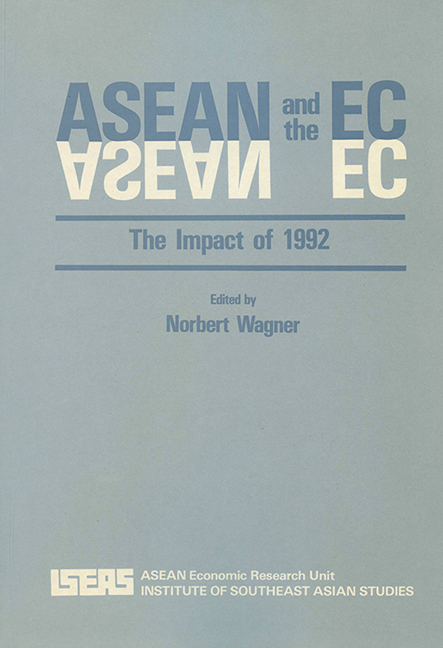Book contents
- Frontmatter
- Contents
- List of Tables
- List of Figures
- Acknowledgements
- PART I INTRODUCTION
- PART II COMPLETING THE EC INTERNAL MARKET
- PART III IMPLICATIONS FOR ASEAN
- V An Analysis of ASEAN-EC Trade in Textiles and Electronics, 1980–88
- VI The EC Internal Market and the ASEAN Electronics Industry
- VII The EC Internal Market and the ASEAN Textile and Clothing Industry
- VIII The Harmonization of Technical Standards and Regulations in the EC: Implications for ASEAN
- IX The EC Internal Market and ASEAN-EC Trade in Services
- X The EC Internal Market and ASEAN-EC Direct Investment Flows
- XI The European Currency System and ASEAN
- Contributors
V - An Analysis of ASEAN-EC Trade in Textiles and Electronics, 1980–88
from PART III - IMPLICATIONS FOR ASEAN
Published online by Cambridge University Press: 09 November 2017
- Frontmatter
- Contents
- List of Tables
- List of Figures
- Acknowledgements
- PART I INTRODUCTION
- PART II COMPLETING THE EC INTERNAL MARKET
- PART III IMPLICATIONS FOR ASEAN
- V An Analysis of ASEAN-EC Trade in Textiles and Electronics, 1980–88
- VI The EC Internal Market and the ASEAN Electronics Industry
- VII The EC Internal Market and the ASEAN Textile and Clothing Industry
- VIII The Harmonization of Technical Standards and Regulations in the EC: Implications for ASEAN
- IX The EC Internal Market and ASEAN-EC Trade in Services
- X The EC Internal Market and ASEAN-EC Direct Investment Flows
- XI The European Currency System and ASEAN
- Contributors
Summary
Introduction
This chapter analyses the trade in textiles and electronics among the members of the Association of Southeast Asian Nations (ASEAN) and those of the European Community (EC) between 1980 and 1988 under three aspects:
Market shares: Determination of the size and growth of ASEAN shares on EC import markets. Comparison of ASEAN's market shares with those of the other Asian newly industrializing countries (NICs) on the one hand and with those of newly industrializing EC-member countries (ECL) on the other. Comparison of actual and hypothetical market shares which would have materialized if the commodity and/or regional composition of ASEAN exports to the EC had been the same as that of total EC trade in textiles and electronics (including intra-EC trade).
Intra-industry trade shares: Determination of the degree of bilateral trade in each product group, of overlapping of exports and imports in ASEAN-EC trade and comparison with those in EC trade with other Asian and European newly industrializing countries. The share of intra-industry trade, of bilateral transactions, as opposed to inter-industry trade, to unilateral transactions, is taken as an indicator of the importance of specific forms of vertical and horizontal specialization between ASEAN and the other NICs on the one hand and the EC on the other.
Export-import price differences: Relative differences between export and import unit prices within single product groups are taken as indicators of the importance of vertical specialization between ASEAN and the other NICs on the one hand and the EC on the other. Vertical specialization in this context means specific patterns of international division of labour across and within product groups: (a) specialization in the overall production of labour-, capital, or research- intensive products; and (b) specialization in labour-, capital-, or research- intensive stages of particular production processes.
The computations are based on EC trade statistics of 1980-88, published by the Statistical Office of the European Community (EUROSTAT).
- Type
- Chapter
- Information
- ASEAN and the ECThe Impact of 1992, pp. 129 - 152Publisher: ISEAS–Yusof Ishak InstitutePrint publication year: 1991

